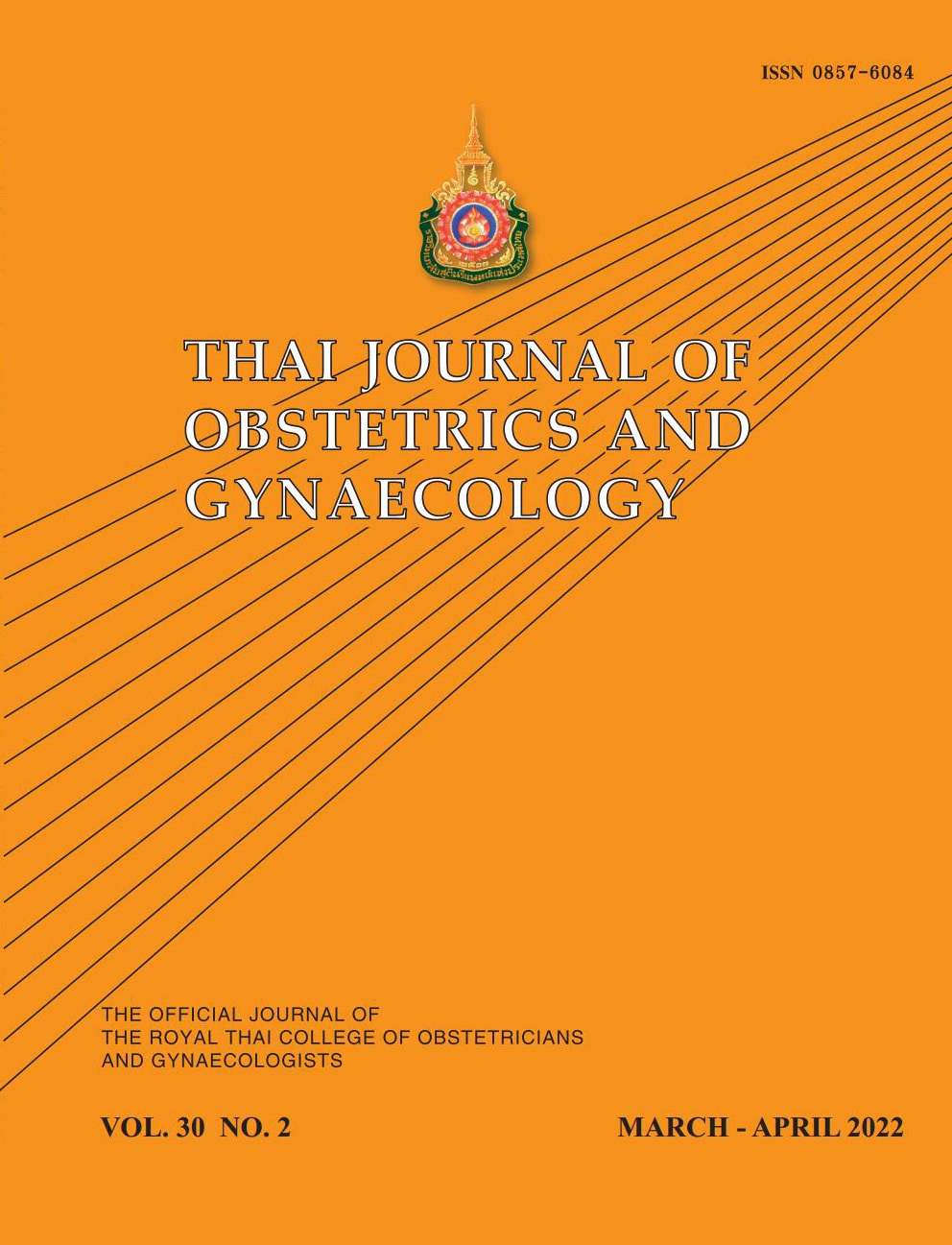Effect of Electric Breast Pump versus Conventional Breastfeeding on Onset of Lactation in Post-cesarean Women: A randomized controlled trial
Main Article Content
Abstract
Objectives: To study the time to onset of lactation (OL) when using an electric breast pump compared with conventional breastfeeding in post-cesarean women.
Materials and Methods: Thirty-four post-cesarean women under spinal block were randomized into two groups: the electric breast pump group (i.e. conventional breastfeeding combined with electric breast pump) and the conventional breastfeeding group. The electric breast pump group started using the electric breast pump within 3 hours of operation, 15 min for each pumping session, every 3 hours after breastfeeding until time to OL. The conventional breastfeeding group breastfed on demand at least 8 times in 24 hours. Post-cesarean women recorded time to OL by maternal perception when they had any one signs and/or symptoms of breast fullness, breast tingling, milk leakage.
Results: The time to OL in the electric breast pump group was significantly earlier than in the conventional breastfeeding group (43.8 ± 11.0 hours versus 68.3 ± 19.9 hours, respectively, p < 0.001). Maternal nipple pain after immediate use of the electric breast pump and breastfeeding (p = 0.74), and length of hospital stay (p = 0.88) were not statistically significant between groups.
Conclusion: Post-cesarean women in the electric breast pump group had significantly earlier time to OL compared with women in the conventional breastfeeding group.
Article Details

This work is licensed under a Creative Commons Attribution-NonCommercial-NoDerivatives 4.0 International License.
References
Gartner LM, Morton J, Lawrence RA. Breastfeeding and the use of human milk. Pediatrics 2005;115:496-506.
Victora CG, Horta BL, Barros FC. Association between breastfeeding and intelligence, educational attainment, and income at 30 years of age: a prospective birth cohort study from brazil. Lancet Glob Health 2015;3:e199-e205.
World Health Organization. Exclusive breastfeeding for six months best for babies everywhere [internet]. 2011 [cite 2019 May 5]. Available from: http://www.who.int/mediacentre/news/statements/2011/breastfeeding_20110115/en/
United Nations Children’s Fund. Breastfeeding a mother’s gift for every child. UNICEF [internet]. 2018 [cite 2019 May 5]:1-5. Available from: https://www.unicef.org/publications/files/UNICEF_Breastfeeding_A_Mothers_Gift_for_Every_Child.pdf
Chapman DJ, Pérez ER. Identification of risk factors for delayed onset of lactation. J Am Diet Assoc1999;99:450-4.
Pillay J, Davis TJ. Physiology Lactation [internet]. Stat Pearls Publishing; 2019 [cite 2019 May 15]. Available from: http://www.ncbi.nlm.nih.gov/books/NBK499981/
Chapman DJ, Pérez ER. Maternal perception of the onset of lactation is a valid, public health indicator of lactogenesis stage II. J Nutr 2000;130:2972–80.
Intarasukum P. Onset of lactation after an uncomplicated cesarean delivery: a study between emergency cesarean delivery and elective cesarean delivery. J Health Sci 2014;23:1058-66.
Jeerasap R, Phaiboonbunpot N, Panikom S. Routes of delivery and onset of lactation. J Health Sci 2010;19:270-8.
Prior E, Santhakumaran S, Gale C, Philipps LH, Modi N, Hyde MJ. Breastfeeding after cesarean delivery: a systemic review and meta-analysis of world literature. Am J Clin Nutr 2012;95:1113-35.
Albokhary AA, James JP. Does cesarean section have an impact on the successful initiation of breastfeeding in Saudi Arabia. Saudi Med J 2014;35:1400-3.
Slusher T, Slusher IL, Biomdo M, Thomas FB, Curtis BA, Meier P. Electric breast pump use increases maternal milk volume in African nurseries. J Trop Pediatr 2007;53:125-30.
Fewtrell MS, Kennedy K, Ahluwalia JS, Nicholl R, Lucas A, Burton P. Predictors of expressed breast milk volume in mothers expressing milk for their preterm infant. Arch Dis Child Fetal Neonatal Ed 2016;101:F502-6.
Zhang F, Yang Y, Bai T, Sun L, Sun M, Shi X, et al. Effect of pumping pressure on onset of lactation after cesarean section: A randomized controlled study. Matern Child Nutr 2018;14:e12486.
World Health Organization. WHO statement on cesarean section rates [internet]. 2015 [cite 2019 May 5]:1-8. Available from: https://apps.who.int/iris/bitstream/handle/10665/161442/WHO_RHR_15.02_eng.pdf?sequence=1
World Health Organization. Ten steps to successful breastfeeding [internet]. 2016 [cite 2019 May 5]. Available from: http://www.who.int/activities/promoting-baby-friendly-hospitals/ten-steps-to-sucessful-breastfeeding.
Branger B. Description of 101 cases of nipple cracks and risk factors via case-control study in eight units of a perinatal network. Arch Pediatr 2020;27:45-50.
Bonyata K. Healing tips for nipple cracks or abrasion [internet]. Michigan; 2018 [cited 2020 Jun 10]. Available from: https://kellymom.com/bf/concerns/mother/nipplehealing/
Kelly E, DunnGalvin G, Murphy BP, Hourihane JB. Formula supplementation remains a risk for cow’s milk allergy in breast-fed infants. Pediatr Allergy Immunol 2019;30:810-6.
Hruschka DJ, Sellen DW, Stein AD, Martorell R. Delayed onset of lactation and risk of ending full breast-feeding early in rural Guatemala. J Nutr 2003;133:2592-9.


